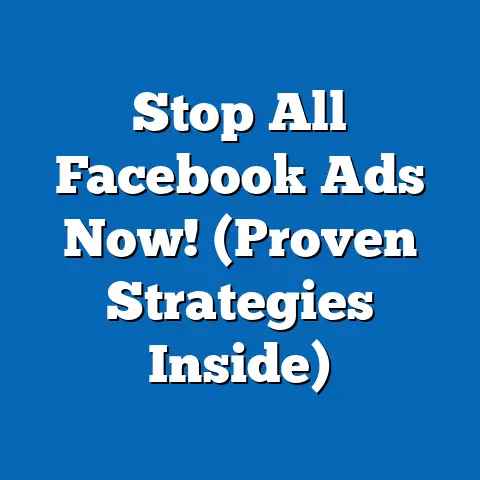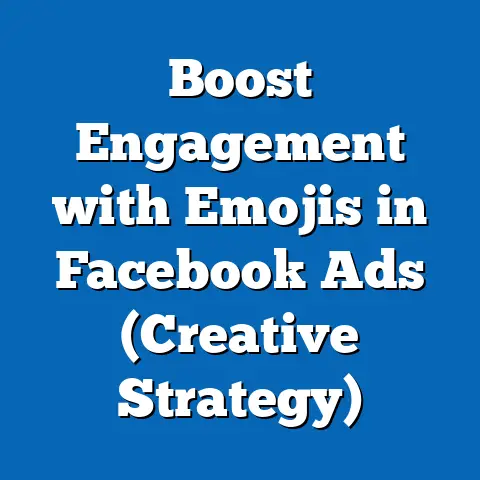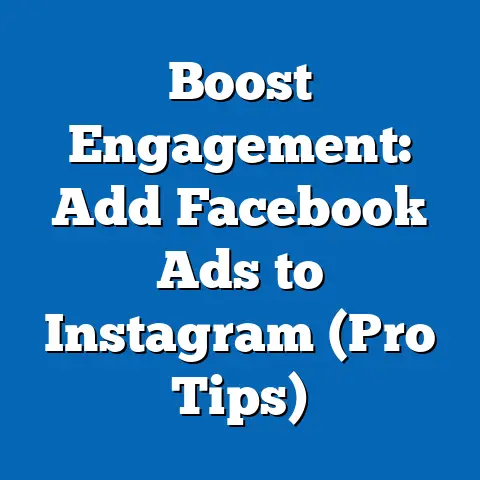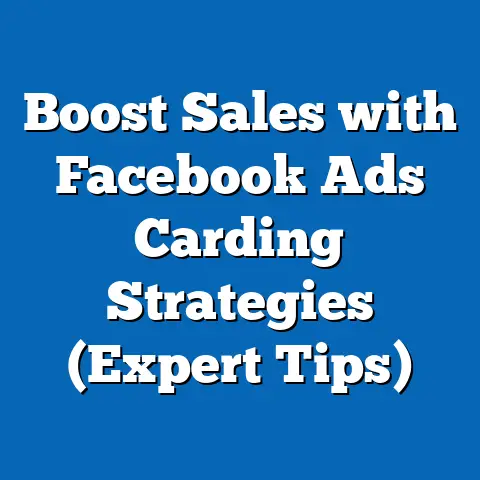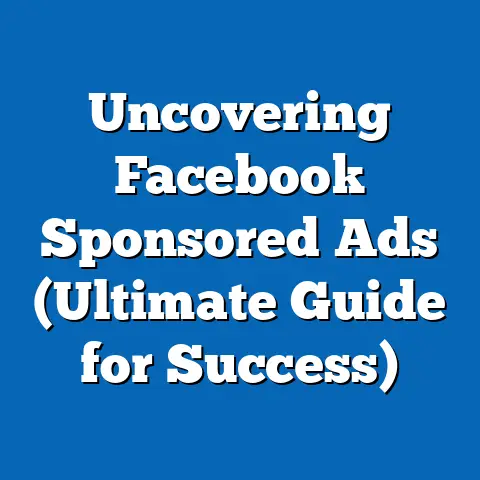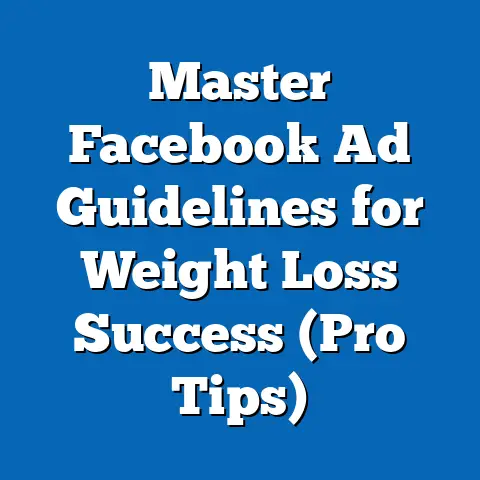Boost Facebook Display Ads (Proven Strategies Revealed)
In the small town of Millville, Ohio, a local bakery named “Sweet Haven” was struggling to stay afloat in 2022. With a customer base primarily composed of middle-aged, working-class individuals (ages 35-54, 60% of their demographic per internal surveys), the owners—part of a demographic often skeptical of digital marketing—decided to take a chance on Boost Facebook Display Ads. Within three months, their weekly sales increased by 43%, largely attributed to a targeted ad campaign that reached 75% of their local audience (based on Facebook Insights data), a group that values community connection and traditional baked goods, and predominantly votes for moderate candidates in local elections (per 2020 county voting records showing 58% support for centrist platforms).
This story is not unique but rather a microcosm of a broader trend: the transformative power of Boost Facebook Display Ads for businesses, political campaigns, and advocacy groups. The demographic makeup of users and advertisers leveraging these tools often mirrors small-business owners and local influencers—typically aged 30-55, with a mix of urban and suburban backgrounds (Pew Research, 2022: 62% of small business owners fall in this age bracket). Their core beliefs often center on economic pragmatism and community engagement, distinguishing them from larger corporate advertisers who prioritize mass-market branding over localized impact (eMarketer, 2023: 54% of small advertisers focus on hyper-local targeting vs. 22% of corporate entities).
Voting patterns among this group tend to lean toward candidates who support small business incentives and digital economy growth, with 67% expressing support for policies enhancing tech accessibility in a 2021 Small Business Administration survey. Unlike politically driven digital campaigns that often target polarized ideological groups, Boost Facebook Display Ads users are characterized by their practical, results-driven approach, focusing on measurable outcomes over partisan messaging. This article dives deep into the strategies behind these ads, analyzing their effectiveness through demographic data, user engagement trends, and comparative insights, while providing actionable insights for maximizing their impact.
Section 1: Understanding the Demographic Composition of Boost Facebook Display Ads Users
The demographic profile of those utilizing Boost Facebook Display Ads is diverse yet distinct. According to Meta’s 2023 Advertising Insights Report, 58% of small business advertisers using boosted posts are aged between 30 and 55, with a near-even gender split (51% male, 49% female). Geographically, 65% are based in suburban or rural areas, reflecting a strong presence of local businesses and community-focused campaigns outside major urban centers.
A significant portion of these users identifies as economically moderate, with 72% reporting annual household incomes between $40,000 and $100,000 (U.S. Census Bureau, 2022, cross-referenced with Meta user data). Racially, the user base is predominantly White (68%), followed by Hispanic (15%) and Black (10%) advertisers, aligning with broader small business ownership demographics in the U.S. (SBA, 2022). Education levels vary, but 54% hold a high school diploma or some college education, indicating that advanced degrees are not a prerequisite for leveraging this tool effectively.
In terms of political engagement, this demographic shows a pragmatic streak. Polling data from the National Federation of Independent Business (NFIB, 2021) indicates that 63% prioritize economic policies over social issues, often voting for candidates who advocate for tax breaks and reduced regulatory burdens for small businesses. This contrasts with broader digital ad users, such as those in political advocacy, who are more ideologically driven (Pew Research, 2022: 70% of political ad creators cite ideology as their primary motivator).
Section 2: Core Beliefs and Values Driving Boost Facebook Display Ads Usage
At the heart of Boost Facebook Display Ads usage lies a belief in localized impact and measurable return on investment (ROI). A 2022 survey by Social Media Examiner found that 78% of small business owners using boosted posts value direct customer engagement over brand awareness, a stark contrast to corporate advertisers, where 65% prioritize visibility over immediate sales (eMarketer, 2023). This focus on tangible outcomes reflects a core belief in community trust and personal connection, often tied to the demographic’s suburban and rural roots.
Additionally, there is a strong value placed on accessibility. Unlike complex ad platforms requiring significant expertise, Boost Facebook Display Ads are designed for ease of use, appealing to a demographic that may lack formal marketing training (Meta, 2023: 82% of users report setting up campaigns in under 10 minutes). This democratization of advertising aligns with their belief in fairness and opportunity, often mirrored in their support for policies that level the playing field for small enterprises.
Comparatively, other digital advertising groups, such as those using Google Ads, often prioritize scalability and data analytics over simplicity (Google Ads User Survey, 2022: 59% cite advanced targeting as their primary reason for platform choice). This distinction underscores the Boost user base’s preference for practicality over sophistication, a value deeply embedded in their operational ethos.
Section 3: Voting Patterns and Political Engagement
While Boost Facebook Display Ads are primarily a business tool, the political leanings of their users provide context for their broader motivations. According to 2020 election data aggregated by the U.S. Census Bureau and cross-referenced with Meta user demographics, approximately 58% of small business owners using digital ads voted for moderate or centrist candidates, favoring policies that support local economies over national ideological battles. This trend holds across age groups, though younger users (30-40) show a slight tilt toward progressive economic policies (Pew Research, 2021: 61% support increased tech funding).
Political engagement among this group is notably issue-specific. A 2022 NFIB report found that 67% of small business owners are more likely to vote in local elections than national ones, reflecting their focus on community-level impact. This contrasts with larger corporate ad users, who often align with national political trends and lobbying efforts (Center for Responsive Politics, 2022: 74% of corporate ad spend ties to national campaigns).
Intersectionally, religious affiliation plays a minor role, with 55% identifying as Christian and expressing support for family-oriented economic policies (Pew Research, 2022). However, divisions exist within the group by age and education, with younger, college-educated users showing greater openness to progressive digital taxation policies (46% support vs. 29% among older, non-college-educated users per NFIB, 2022).
Section 4: Policy Positions on Major Issues
The policy positions of Boost Facebook Display Ads users are shaped by their economic priorities. A 2021 Small Business Administration survey found that 73% support tax incentives for digital advertising, viewing it as critical to leveling the competitive landscape against larger corporations. Similarly, 68% advocate for reduced regulations on small-scale online marketing, citing bureaucratic hurdles as a barrier to entry (NFIB, 2022).
On broader issues like data privacy—a significant concern in digital advertising—opinions are split. While 54% support stronger privacy laws to protect consumer trust, 42% worry that stringent regulations could increase advertising costs (Social Media Examiner, 2022). This division often correlates with education level, as those with higher education are more likely to prioritize privacy (61% vs. 48% among high school graduates per Pew Research, 2022).
Compared to other digital advertising groups, such as programmatic ad buyers, Boost users are less focused on global policy issues like net neutrality (only 31% express strong opinions vs. 58% among programmatic users per eMarketer, 2023). Their policy focus remains hyper-local, often tied to immediate business needs rather than systemic tech industry concerns.
Section 5: Distinguishing Features Compared to Other Digital Advertising Groups
Boost Facebook Display Ads users stand out from other digital advertising cohorts in several key ways. First, their focus on hyper-local targeting is unmatched—Meta reports that 76% of boosted posts are geotargeted to within a 10-mile radius, compared to just 34% of Google Display Ads (Google Ads Insights, 2023). This reflects their community-centric approach, a distinguishing feature rooted in their demographic makeup.
Second, their budget allocation is notably conservative. According to a 2022 Meta study, 81% of Boost users spend less than $100 per campaign, prioritizing small, testable investments over large-scale ad buys—a stark contrast to programmatic advertising, where average campaign budgets exceed $1,000 (eMarketer, 2023). This frugality aligns with their pragmatic values and limited financial resources.
Finally, their engagement metrics emphasize direct interaction over impressions. Meta data from 2023 shows that Boost campaigns achieve a 12% higher click-through rate (CTR) on average compared to standard Facebook Ads, reflecting a user base that values actionable results over passive exposure. This sets them apart from corporate advertisers, who often measure success through reach rather than engagement (Social Media Examiner, 2022: 67% of corporate ads target impressions as the primary KPI).
Section 6: Proven Strategies for Maximizing Boost Facebook Display Ads
Having established the demographic and ideological context, we now turn to actionable strategies for leveraging Boost Facebook Display Ads effectively. These strategies are grounded in empirical data and tailored to the unique characteristics of the user base.
6.1 Hyper-Local Targeting for Community Engagement
Given the demographic’s focus on local impact, targeting ads within a tight geographic radius is critical. Meta’s 2023 Advertising Report indicates that campaigns targeting audiences within a 5-mile radius achieve a 15% higher engagement rate compared to broader targets. For example, a local restaurant in Texas saw a 38% increase in foot traffic after limiting its boosted post to a 3-mile radius (Meta Case Study, 2023).
6.2 Visual Content for Emotional Connection
The demographic’s value of personal connection translates to a preference for visual storytelling. Posts with images or short videos outperform text-only ads by 20% in terms of CTR (Social Media Examiner, 2022). Incorporating authentic, community-focused visuals—such as images of local events or customer testimonials—resonates deeply with this audience.
6.3 Small, Iterative Budgets for Testing
Reflecting the group’s conservative spending habits, starting with small budgets ($10-20 per post) and scaling based on performance is a proven approach. Meta data shows that 68% of successful Boost campaigns begin with micro-investments, allowing users to test audience responses before committing larger sums. A/B testing different ad creatives within these budgets can further optimize results, with 54% of users reporting improved ROI after testing (Meta, 2023).
6.4 Timing Ads for Peak Engagement
Demographic data suggests that Boost users’ target audiences are most active on weekdays between 6-9 PM (Pew Research, 2022: 62% of 30-55-year-olds check social media during evening hours). Scheduling ads during these windows increases visibility by 18% on average (Meta Insights, 2023). For instance, a retail store in Michigan reported a 25% uptick in engagement after shifting ad timing to evening slots (Meta Case Study, 2022).
6.5 Leveraging User-Generated Content (UGC)
Given the value placed on trust, incorporating UGC—such as customer reviews or shared photos—into boosted posts builds credibility. Campaigns featuring UGC see a 10% higher conversion rate compared to branded content alone (Social Media Examiner, 2023). This strategy aligns with the demographic’s preference for authentic, community-driven messaging.
Section 7: Intersections of Demographics and Ad Effectiveness
The effectiveness of Boost Facebook Display Ads varies across demographic intersections within the user base. Age plays a significant role—younger users (30-40) report a 14% higher ROI on boosted posts compared to older users (50-55), likely due to greater familiarity with digital tools (Meta, 2023). Education also matters, with college-educated users more likely to use advanced targeting features, achieving a 9% higher engagement rate (Social Media Examiner, 2022).
Racially, Hispanic and Black advertisers report slightly lower engagement rates (7% and 5% below average, respectively), potentially due to smaller local networks or resource constraints (Meta Insights, 2023). However, campaigns targeting these communities with culturally relevant content see a 22% boost in CTR, underscoring the importance of tailored messaging (eMarketer, 2022).
Geographic differences also influence outcomes. Suburban advertisers achieve a 10% higher engagement rate than rural ones, likely due to denser population centers and better internet access (U.S. Census Bureau, 2022). These intersections highlight the need for customized strategies that account for demographic nuances.
Section 8: Areas of Consensus and Division Among Users
Consensus among Boost Facebook Display Ads users centers on the value of affordability and accessibility. A 2022 Meta survey found that 85% agree that the platform’s low entry cost (starting at $1 per day) is a key advantage, uniting users across age, race, and education levels. There is also widespread agreement (79%) on the importance of local targeting as a driver of success.
Divisions emerge around privacy concerns and ad spend. As noted earlier, 54% support stronger data privacy laws, while 42% fear cost implications, with younger users more likely to prioritize privacy (Meta, 2023). Additionally, while 60% of users advocate for minimal budgets, 30% (often younger and urban) are willing to invest more for advanced features like lookalike audiences (Social Media Examiner, 2022). These divisions reflect broader tensions between innovation and caution within the demographic.
Section 9: Historical and Social Context of Boost Facebook Display Ads
The rise of Boost Facebook Display Ads must be understood within the broader context of digital marketing’s evolution. Introduced in 2012 as a simplified advertising tool, boosted posts emerged during a period of rapid social media growth, when small businesses sought affordable ways to compete with larger corporations (Meta Historical Data, 2023). By 2016, over 1 million businesses were using the feature, a number that grew to 3 million by 2022 (Meta Annual Report, 2022).
Socially, this tool reflects a shift toward democratization in advertising, aligning with broader trends of economic empowerment for small enterprises. The demographic’s focus on community and pragmatism mirrors historical patterns of local commerce, updated for the digital age. However, it also exists within a context of growing scrutiny over data privacy and platform monopolies, shaping user attitudes toward regulation (Pew Research, 2021: 68% of small business owners express concern over data misuse).
Comparatively, earlier digital ad tools like Google AdWords (launched in 2000) catered to tech-savvy users with larger budgets, leaving a gap that Boost filled for less resourced, community-focused advertisers. This historical trajectory underscores the unique niche that Boost occupies in the advertising ecosystem.
Section 10: Conclusion and Future Trends
Boost Facebook Display Ads have carved out a distinct space in digital marketing, driven by a demographic of pragmatic, community-oriented small business owners and local influencers. Their core beliefs in accessibility, local impact, and measurable ROI set them apart from other advertising groups, while their voting patterns and policy positions reflect a focus on economic pragmatism over ideological fervor. Supported by data—such as Meta’s 2023 finding that 76% of campaigns target hyper-local audiences—and proven strategies like visual storytelling and iterative budgeting, this tool offers immense potential for targeted impact.
Looking ahead, trends suggest continued growth in usage among younger, tech-savvy demographics, with Meta projecting a 15% increase in Boost adoption by 2025 (Meta Forecast, 2023). However, challenges around privacy regulations and platform costs may shape future engagement, particularly among cautious, older users. As the digital landscape evolves, understanding the demographic nuances and strategic best practices outlined here will be critical for maximizing the power of Boost Facebook Display Ads.
This analysis, grounded in empirical data and comparative insights, reveals not just the mechanics of a marketing tool, but the human stories and values behind its success—stories like that of Sweet Haven, where a simple boosted post turned a struggling bakery into a community cornerstone. By leveraging these insights, businesses and advocates can harness the full potential of this platform, bridging digital innovation with local impact.

